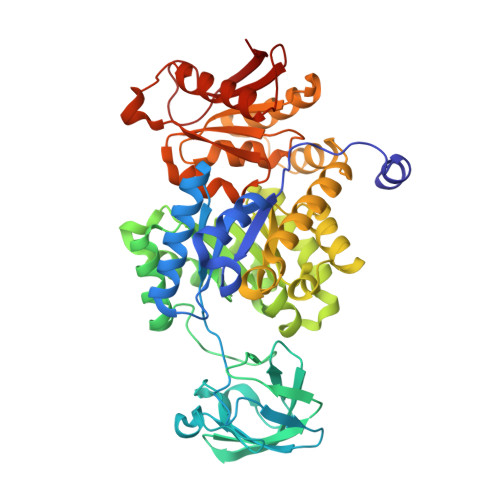Pyruvate kinases have an intrinsic and conserved decarboxylase activity.
Zhong, W., Morgan, H.P., Nowicki, M.W., McNae, I.W., Yuan, M., Bella, J., Michels, P.A., Fothergill-Gilmore, L.A., Walkinshaw, M.D.(2014) Biochem J 458: 301-311
- PubMed: 24328825
- DOI: https://doi.org/10.1042/BJ20130790
- Primary Citation of Related Structures:
4KCT, 4KCU, 4KCV, 4KCW - PubMed Abstract:
The phosphotransfer mechanism of PYKs (pyruvate kinases) has been studied in detail, but the mechanism of the intrinsic decarboxylase reaction catalysed by PYKs is still unknown. 1H NMR was used in the present study to follow OAA (oxaloacetate) decarboxylation by trypanosomatid and human PYKs confirming that the decarboxylase activity is conserved across distantly related species. Crystal structures of TbPYK (Trypanosoma brucei PYK) complexed with the product of the decarboxylase reaction (pyruvate), and a series of substrate analogues (D-malate, 2-oxoglutarate and oxalate) show that the OAA analogues bind to the kinase active site with similar binding modes, confirming that both decarboxylase and kinase activities share a common site for substrate binding and catalysis. Decarboxylation of OAA as monitored by NMR for TbPYK has a relatively low turnover with values of 0.86 s-1 and 1.47 s-1 in the absence and presence of F26BP (fructose 2,6-bisphosphate) respectively. Human M1PYK (M1 isoform of PYK) has a measured turnover value of 0.50 s-1. The X-ray structures explain why the decarboxylation activity is specific for OAA and is not general for α-oxo acid analogues. Conservation of the decarboxylase reaction across divergent species is a consequence of piggybacking on the conserved kinase mechanism which requires a stabilized enol intermediate.
Organizational Affiliation:
*Centre for Translational and Chemical Biology, School of Biological Sciences, University of Edinburgh, Michael Swann Building, The King's Buildings, Mayfield Road, Edinburgh EH9 3JR, U.K.


















